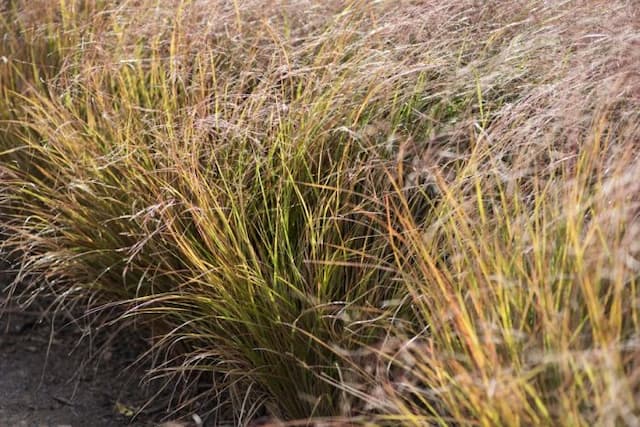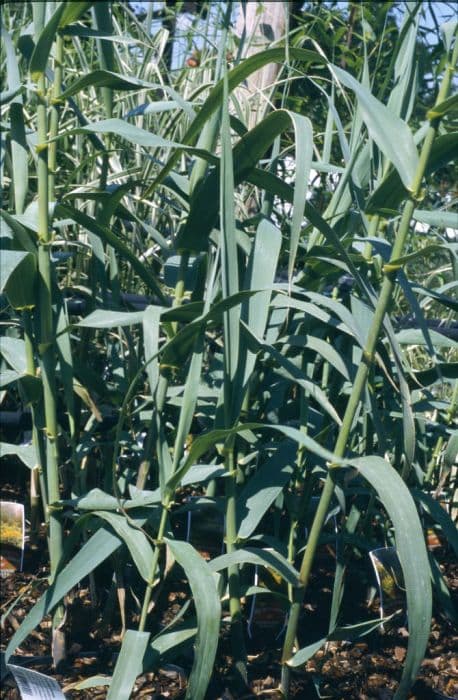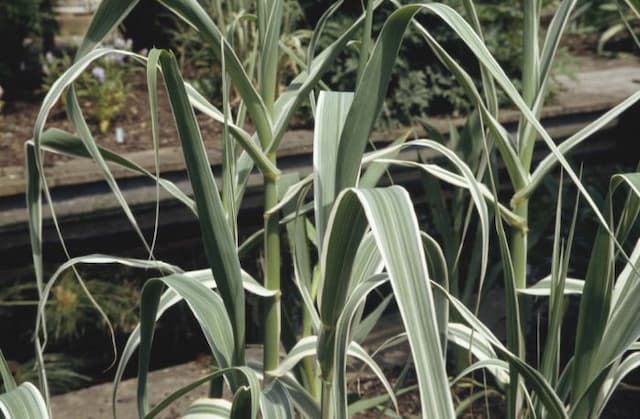Pampas Grass Cortaderia selloana 'Sunningdale Silver'

ABOUT
The plant commonly known as 'Sunningdale Silver' is a striking ornamental grass that boasts large, feathery plumes which bear a silvery-white color that glistens under sunlight. The plumes are dense and fluffy, giving the plant a soft and inviting texture from a distance. Beneath these radiant plumes, the plant sports a tuft of arching foliage. The leaves are thin and long, with a sharp edge that can be rather cutting when handled without care. This foliage is typically a deep green with a hint of blue, creating a beautiful contrast against the bright plumes that tower above. The overall appearance of 'Sunningdale Silver' is one of grandeur and elegance; its plumes sway gracefully with the wind, adding movement and life to landscapes. This plant maintains a clump-forming habit, presenting a tidy yet natural look that is highly prized in garden design. The combination of its silvery plumes and blue-green foliage makes it a popular choice for adding texture and color in gardens, and it is often used as a statement piece or in mass plantings for visual impact. However, it is essential to note that while the plant is beautiful, it is also quite robust and can spread if not properly managed.
About this plant
 Names
NamesFamily
Poaceae
Synonyms
Pampas Grass, Andean Pampas Grass, Silver Pampas Grass
Common names
Cortaderia selloana 'Sunningdale Silver'.
 Toxicity
ToxicityTo humans
Pampas grass is not considered toxic if ingested by humans. However, it's important to be aware that the leaves of pampas grass can have sharp edges, and handling the plant can cause physical irritation or injuries to the skin.
To pets
Pampas grass is also not known to be toxic to pets if ingested. Similar to humans, the primary concern is the physical irritation or injury caused by the plant's sharp leaves, which can be harmful if pets come into contact with them.
 Characteristics
CharacteristicsLife cycle
Perennials
Foliage type
Evergreen
Color of leaves
Green
Flower color
Varies
Height
6-10 feet (1.8-3 meters)
Spread
4-6 feet (1.2-1.8 meters)
Plant type
Grass
Hardiness zones
7
Native area
South America
Benefits
 General Benefits
General Benefits- Ornamental Appeal: Adds aesthetic value to gardens with its striking silver plumes and graceful foliage.
- Drought Tolerance: Once established, it is highly drought-resistant, requiring minimal water.
- Low Maintenance: Requires little care beyond the occasional pruning to maintain its shape.
- Windbreak: Can be used effectively as a wind barrier due to its robust and dense growth.
- Privacy Screen: With its tall growth habit, it can provide privacy in gardens or around patios.
- Soil Erosion Control: Its extensive root system helps to stabilize soil and prevent erosion.
- Wildlife Support: Provides shelter and nesting sites for birds while its flowers attract bees.
- Long-Lived: This perennial plant can live for many years, providing long-term landscaping benefits.
- Seasonal Interest: Offers year-round visual interest but is particularly stunning when it blooms in late summer or autumn.
- Versatility: Suitable for a range of garden styles, from contemporary to cottage gardens.
 Medical Properties
Medical PropertiesThis plant is not used for medical purposes.
 Air-purifying Qualities
Air-purifying QualitiesThis plant is not specifically known for air purifying qualities.
 Other Uses
Other Uses- Cortaderia selloana, commonly known as pampas grass, can be used as a sound barrier when planted in dense rows due to its thick foliage, which helps absorb noise pollution.
- The tall and dense growth habit of pampas grass makes it suitable for creating privacy screens in gardens and around private areas.
- Dried pampas grass plumes are often used in floral arrangements and as statement pieces in interior design to add a touch of elegance and height.
- The stems of pampas grass are sturdy enough to be used in crafting, such as in the making of DIY dream catchers or other decorative hangings.
- During the winter, pampas grass can serve as a protective habitat for beneficial insects and small wildlife seeking refuge from the cold.
- The plumes of pampas grass can be spray-painted to create colorful outdoor art installations or festival decorations.
- Pampas grass can be used as a natural windbreak for smaller plants in the garden, reducing wind damage to more delicate species.
- In coastal areas, pampas grass is sometimes planted to stabilize sand dunes and prevent soil erosion with its deep root system.
- Dried pampas grass strands can be woven into mats, hats, or baskets as part of traditional handicrafts in some cultures.
- When left untrimmed, the thick foliage of pampas grass can act as a natural snow fence, trapping snow and preventing drifts on pathways or roads.
Interesting Facts
 Feng Shui
Feng ShuiPampas grass is not used in Feng Shui practice.
 Zodiac Sign Compitability
Zodiac Sign CompitabilityPampas grass is not used in astrology practice.
 Plant Symbolism
Plant Symbolism- Strength and Resilience: Cortaderia selloana, commonly known as Pampas Grass, is known for its ability to thrive in harsh conditions, symbolizing the ability to stand firm and endure challenges.
- Beauty and Softness: The silky plumes and graceful form of Pampas Grass represent beauty and softness, signifying gentleness and an inviting nature.
- Privacy and Protection: Pampas Grass is often used in landscaping to create natural barriers, symbolizing the desire for privacy and the need for protection.
- Growth and Fertility: With its rapid and prolific growth habit, Pampas Grass can also symbolize fertility and abundance, echoing the plant's own lush, spreading nature.
 Water
WaterPampas Grass should be watered deeply about once a week, allowing the soil to dry out between waterings. During the growing season, aim for about 1 to 1.5 inches of water per week, which equates to approximately 0.5 to 0.75 gallons for an established plant. In hotter, drier periods, you might need to water more frequently to keep the soil consistently moist, but not waterlogged. Over the winter, reduce watering since the plant is not actively growing and excess water can lead to root rot.
 Light
LightPampas Grass thrives in full sun with at least 6 hours of direct sunlight daily. The best spot for this plant is an open area without shade from trees or buildings to ensure it receives ample sunlight, which is essential for the plant's vigorous growth and the development of its characteristic plumes.
 Temperature
TemperaturePampas Grass is hardy and can tolerate a range of temperatures, but it grows best in areas where the temperature stays between 40 to 90 degrees Fahrenheit. It can withstand temperatures down to about 20 degrees Fahrenheit but may sustain damage or die back if exposed to extremes below this range. The ideal temperature conditions for active growth are within 70 to 80 degrees Fahrenheit.
 Pruning
PruningPrune Pampas Grass in late winter or early spring before new growth starts, cutting back to about a foot or two above ground level. This yearly pruning encourages healthy new growth, maintains the plant's shape, and prevents it from becoming too large and unwieldy. The best time for pruning is when the plant is dormant, reducing stress on the plant.
 Cleaning
CleaningAs needed
 Soil
SoilPampas Grass thrives in a well-draining soil mix with a pH ranging from 6.1 to 7.5. A mix of loam, compost, and a small amount of sand or perlite is ideal to ensure proper drainage and fertility.
 Repotting
RepottingPampas Grass in containers should be repotted every 2 to 4 years to refresh the soil and accommodate root growth, although mature plants may be repotted less frequently.
 Humidity & Misting
Humidity & MistingPampas Grass tolerates a wide range of humidity levels but prefers moderate ambient moisture without the need for supplemental humidity.
 Suitable locations
Suitable locationsIndoor
Provide full sun and don’t overwater Pampas Grass.
Outdoor
Plant in full sun, in well-draining soil; water moderately.
Hardiness zone
7-11 USDA
 Life cycle
Life cyclePampas grass, commonly known as Cortaderia selloana 'Sunningdale Silver', starts its life cycle as a seed, which upon finding suitable soil and environmental conditions, will germinate. As it emerges from the ground, it grows into a small grassy clump. Over time, the plant matures and forms an extensive root system, whilst above ground, it develops long, razor-edged leaves and expands into a larger, dense tussock. In late summer to early fall, it produces tall, feathery flower plumes that may range in color from white to silvery-grey, which are highly ornamental. After pollination by wind, seeds are produced and dispersed, allowing the life cycle to continue when they germinate in a suitable location. In the final stage of its life, after several years, the plant's growth slows down, and it may eventually die back, especially in harsh climates or if conditions become unsuitable, though the plant may also self-seed before this happens.
 Propogation
PropogationPropogation time
Early spring
Propogation: Pampas Grass 'Sunningdale Silver' is typically propagated through division, which is the most popular method. This process should be conducted in the late winter or early spring, just before new growth begins for the season. To propagate by division, you'll want to dig up an established clump of Pampas Grass and gently separate it into smaller sections, each with a portion of roots and shoots. Once separated, you can replant the divisions into pots or directly into the garden, ensuring that they have ample space to grow. It is important to water the newly planted divisions thoroughly and keep the soil consistently moist until the plants are established.









